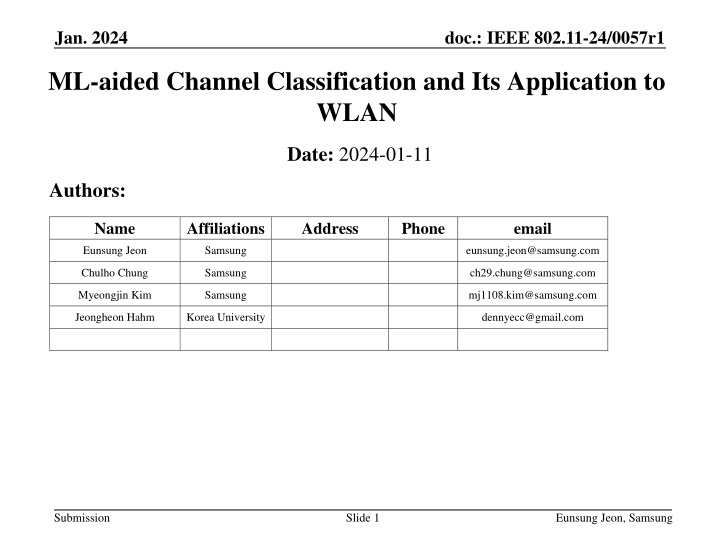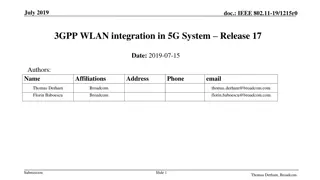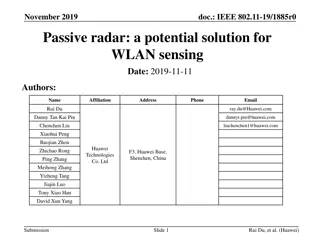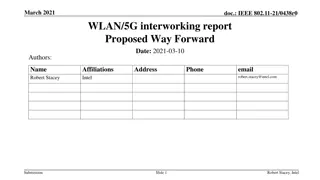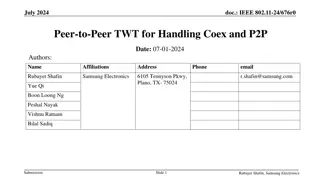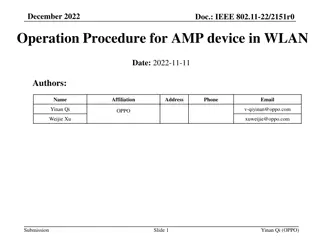ML-Aided Channel Classification for WLAN Optimization
The paper discusses using machine learning to classify IEEE channel models and improve WLAN performance. It demonstrates how neural networks can accurately classify channel types, leading to efficient beamforming and signal processing. Simulation results show the classification performance even at low SNR levels. The study presents a use case for beamforming based on channel type information feedback.
Download Presentation

Please find below an Image/Link to download the presentation.
The content on the website is provided AS IS for your information and personal use only. It may not be sold, licensed, or shared on other websites without obtaining consent from the author.If you encounter any issues during the download, it is possible that the publisher has removed the file from their server.
You are allowed to download the files provided on this website for personal or commercial use, subject to the condition that they are used lawfully. All files are the property of their respective owners.
The content on the website is provided AS IS for your information and personal use only. It may not be sold, licensed, or shared on other websites without obtaining consent from the author.
E N D
Presentation Transcript
Jan. 2024 doc.: IEEE 802.11-24/0057r1 ML-aided Channel Classification and Its Application to WLAN Date: 2024-01-11 Authors: Name Affiliations Address Phone email Eunsung Jeon Samsung eunsung.jeon@samsung.com Chulho Chung Samsung ch29.chung@samsung.com Myeongjin Kim Samsung mj1108.kim@samsung.com Jeongheon Hahm Korea University dennyecc@gmail.com Submission Slide 1 Eunsung Jeon, Samsung
Jan. 2024 doc.: IEEE 802.11-24/0057r1 Introduction The IEEE channel model is classified into A, B, C, D, and E in the order of high frequency selectivity. In [1], we showed that the neural network based machine learning (ML) can achieve close to perfect classification result by using the multi-dimensional (i.e., time & frequency domain) channel measurements as preprocessors of the neural network. We also showed that the classification result can provide a beamformee to select an appropriate subcarrier grouping (Ng) value to reduce overhead required for CSI feedback. Following [1], this contribution presents additional use-cases of how the channel classification can be used for the improvement of WLANs. Slide 2 Submission Eunsung Jeon, Samsung
Jan. 2024 doc.: IEEE 802.11-24/0057r1 Recap: Neural Network based Channel Classification [1] The neural network is trained in advance by using the three- dimensional channel measurements as its inputs. Variance of CFR (channel frequency response) Delay spread of CIR (channel impulse response) SNR And then, for a new channel measurement, its channel type is identified in real-time manner by the trained neural network. Submission Slide 3 Eunsung Jeon, Samsung
Jan. 2024 doc.: IEEE 802.11-24/0057r1 Recap: Neural Network based Channel Classification [1] Simulation results For 1,000 channel samples, the classification performance is evaluated. We can see very accurate classification performance, even for low SNR. SNR = 5dB SNR = 15dB SNR = 25dB A B C D E F A B C D E F A B C D E F Ch. C 2 998 Ch. C Ch. D 2 Ch. D 998 2 Ch. C 505 495 Ch. E 3 997 SNR = 35dB SNR = 45dB A B C D E F A B C D E F : Correct classification : False classification Ch. D 1 999 Submission Slide 4 Eunsung Jeon, Samsung
Jan. 2024 doc.: IEEE 802.11-24/0057r1 Use-case 1: Beamforming A high level design of channel type information feedback procedure is as follow. Beamformer that solicits channel type information transmits NDPA, where channel type information subfield may be set with three options. Option Bit size Channel Type Information Flat (0) Flat (00) Ch. A (000) Selective (1) Very Selective (10) Ch. E (100) Coarse 1 Selective (01) Ch. B (001) Reserved (11) Reserved (110), (111) Fine 2 Ch. C (010) Ch. D (011) Ch. F (101) Very Fine 3 Upon the receipt of the NDP, beamformee applies an AIML technique (e.g., a Neural Network) to derive channel type information and feeds back the channel type information in a compressed beamforming report frame. Submission Slide 5 Eunsung Jeon, Samsung
Jan. 2024 doc.: IEEE 802.11-24/0057r1 Use-case 1: Beamforming (Cont.) Based on the channel type information, beamformer selects the subcarrier grouping value (Ng) or codebook size adaptively. For example, Ng Channel Type Information Codebook size (bits for ( , )) Ch. A, Ch. B, Ch. C (2, 4) bits Ng = 16 Ch. D, Ch. E, Ch. F (4, 6) bits Ng = 4 Submission Slide 6 Eunsung Jeon, Samsung
Jan. 2024 doc.: IEEE 802.11-24/0057r1 Use-case 2: mm-Wave Transmission At 60 GHz band, the channel propagation loss is more severe than 2 GHz or 5 GHz channels [2]. In the figure below, we can that the performance gap can reach up to 3dB between the LOS and Non-LOS (NLOS) channel. Without an accurate channel type identification, throughput loss will be incurred if a LOS channel is identified as a NLOS channel. Packet error rate (PER) performance of IEEE 802.11ad [3] Submission Slide 7 Eunsung Jeon, Samsung
Jan. 2024 doc.: IEEE 802.11-24/0057r1 Use-case 2: mm-Wave Transmission (Cont.) An example of high level design for channel type information feedback is as follow. AP transmits a new Trigger frame to solicit the channel type information. A new Trigger variant as shown in the table below. Non-AP STAs identified by the AID12 subfield of a User Info transmits a TB-PPDU carrying a channel type information. The availability of mm-Wave transmission is based on channel type information. Submission Slide 8 Eunsung Jeon, Samsung
Jan. 2024 doc.: IEEE 802.11-24/0057r1 Use-case 3: Link Adaptation The main goal of the link adaptation is to adjust the transmission scheme (i.e. MCS level and number of spatial streams) according to the channel condition. Generally used link adaptation methods would be ARF (Auto Rate Fall-back) Increase the data rate if several packet transmission was successful and otherwise lower the data rate if the packet transmission failure [3]. PHY-abstraction Predict PER performance based on the AWGN based link performance modeling [4]. If the channel type information is available to AP, AP can predict more accurate PER performance based on the link performance modeling of the given channel type. MAC header may carry the channel type information. Channel Type Info. MAC Header Data FCS Submission Slide 9 Eunsung Jeon, Samsung
Jan. 2024 doc.: IEEE 802.11-24/0057r1 Use-case 4: FTM FTM (Fine Timing Measurement) is a Wi-Fi based indoor positioning protocol, which relies on Measurement of the time from transmitting a frame (ToD) to receiving the ACK (ToA). In case of severe multi-path channel, fractional delay estimation and its calibration is a main issue to guarantee 1 meter-level positioning accuracy. The channel type information can be helpful for measurement timing calibration. For example, the channel type information indicates a Ch. A, there will be no calibration, and large scale calibration will be required when indicating a Ch. F. Submission Slide 10 Eunsung Jeon, Samsung
Jan. 2024 doc.: IEEE 802.11-24/0057r1 Summary We discussed a AIML aided channel classification and feedback of channel type information for the potential improvement of 802.11 WLANs in the following use-cases. Beamforming mm-Wave transmission Link adaptation FTM Submission Slide 11 Eunsung Jeon, Samsung
Jan. 2024 doc.: IEEE 802.11-24/0057r1 Reference [1] 802.11-23/0032r3, ML-based Adaptive Subcarrier Grouping for Beamforming Feedback, Samsung. [2] E. Kurniawan, L. Zhiwei, and S. Sun, Machine Learning-Based Channel Classification and Its Application to IEEE 802.11ad Communications, in Proc. IEEE Global Communications Conference (GLOBECOM), Dec. 2017. [3] A. Kamerman and L. Monteban, WaveLAN-II: A high-performance wireless LAN for the unlicensed band, Bell. Labs Tech. Journal, 1997. [4] IEEE 802.16m, Evaluation Methodology Document (EMD), IEEE 802.16m- 08/004r5, Jan. 2009. Submission Slide 12 Eunsung Jeon, Samsung
